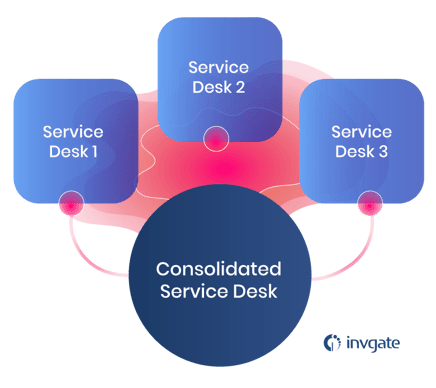If you read our earlier blog “The Common Issues with Operating Multiple IT Service Desk Tools,” then you’re hopefully better aware of all the issues caused by running multiple service desk tools and potentially now looking at how to justify ITSM tools consolidation project. To help, this blog shares some of the key opportunities to create a compelling business case for change.
This is more than tool consolidation though
This point needs to be called out right upfront when justifying the costs of IT service desk or IT service management (ITSM) tool consolidation. That there’s so much more to justify than the cost of the consolidated tool and its implementation – because this is a people and process change as well as being a technology change.
Thankfully, your business case can also include the benefits related to these people and process changes as well as the benefits of having a single tool.
Start with the many issues of operating multiple service desks
Not all of these will affect your organization but they’re a good checklist for identifying how having a single IT service desk tool is going to benefit it. These are described in more detail in the aforementioned “The Common Issues with Operating Multiple IT Service Desk Tools” blog and summarized below:
- The total cost of ownership (TCO) is higher than it could be
- IT operations and outcomes will likely differ across tools and teams
- Additional tooling needs (and costs)
- Supplier relationship complexity
- Additional skills are needed
- Knowledge management is harder
- Intra-team working is problematic
- Performance management is siloed
- Enterprise service management and digital transformation ambitions are stifled
This exercise will highlight opportunities for both hard and soft benefits related to the consolidation when the as-is and desired future states are considered through a “better, faster, cheaper” lens. You might have a preferred method for building out a business case for change, but the systematic analysis of what’s wrong and what can be improved upon (which can include capabilities that are already acceptable) is usually a good starting point.

Then quantify the potential benefits
Once the various improvement areas have been identified they should be fleshed out, grouped, and quantified where possible – especially in financial terms for hard benefits. For example, when the TCO of operating multiple IT service desk tools is considered, there are various elements to consider – from volume-based licensing inefficiencies, through the increased upgrade costs, to the additional operating and management costs.
This process will have many possible elements that potentially go further than the initial thinking, eking out subareas of potential benefit realization. Here the grouping of improvement areas helps to extend the benefit-based thinking as well as helping to avoid the double-counting of benefits.
What this looks like in practice
So, quickly highlighting some of the key improvement opportunities, consolidating onto a single IT service desk tool brings not only the aforementioned ability to benefit from volume licensing discounts but also opportunities such as right-sizing the cost to value, i.e. not overpaying relative to what’s used. Or the ability to pool licenses across teams to reduce the TCO.
Then there’s only one tool to manage. This delivers a variety of cost savings – whether this is training staff to use it, the efforts and costs of administration including change, the associated integration and upgrade costs, through to the greater use of automation across teams using the “create once, use many” philosophy.
Some of the big-hitter cost savings will come from the labour-based operational improvements made through consistency and better-automated capabilities. These not only apply to the work undertaken by service desk staff but potentially also the positive impact on employees and business operations. For example, when the shortening of resolution times increases employee productivity or when improved problem management or major incident management capabilities reduce service downtime and the adverse business impact.
Look at the enterprise-wide benefits
While the main issues at hand are related to the IT organization’s operations and outcomes, another area to consider for your business case is the business-wide benefit of extending the use of the It service desk tool use outside of IT – whether as part of an enterprise service management approach or fulfilling elements of the corporate digital transformation strategy. This might bring with it higher benefits than those seen in IT, with the tool consolidation initiative vital in bringing them about.
Don’t forget the impact on demand
When logging all the improvements that IT service desk tool consolidation will bring, it’s also important to consider how the better operations that result might increase demand. Where, thanks to better engagements and experiences, employees are less likely to use other routes or to suffer in silence (with the associated productivity impact). This applies to all service and support channels too – with the increased employee use of the self-service channel, because they now want to use the improved capability, another contributor of benefits.
What to know more? Learn how McDonald's consolidated multiple service desk with InvGate Service Management.















